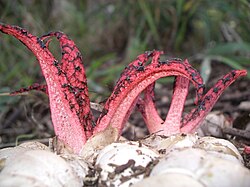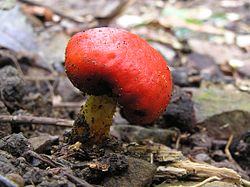31:
331:
200:
112:
182:
This convenient division continued to be used for the next 150 years or so, although by the middle of the twentieth century it had become evident that
Gasteromycetes was an artificial class (bringing together a miscellany of unrelated species) and not a natural one. In a 1995 study of British
275:, form spores within internally gelatinous, puffball-like 'eggs'. At maturity the eggs split and various strange spore-receptacles emerge. The spores are coated with a putrid smelling slime that attracts flies—these being the agents of dispersal.
290:, form miniature, egg-like packets of spores within cup-shaped fruit bodies. These packets of spores are ejected by rain-splash and may land some distance away, the packets gradually wearing away to release the spores themselves.
187:, but they cannot be classified as a single group." DNA-based systematic research hasn't unexpectedly, confirmed the diversity of the gasteroid fungi; According to a 2011 estimate, gasteroid fungi comprise about 8.4% of the known
238:, spores are formed within spherical to pestle-shaped fruit bodies and are released either by wind (as the fruit body wears away, exposing the spore mass inside) or by raindrops. In the latter case, the fruit bodies develop an
311:
develop underground or at the soil surface. As with the true truffles, some of them have distinctive smells and are actively hunted out by small mammals which may consume them and spread their spores. Some New
Zealand
658:
Wilson AW, Binder M, Hibbett DS (2011). "eEffects of gasteroid fruiting body morphology on diversification rates in three independent clades of fungi estimated using binary state speciation and extinction analysis".
183:
species, by Pegler et al. noted that "these fungi represent an heterogeneous assemblage, a mixture of forms which are derived from various lineages. ... can be collectively referred to as
242:(apical hole) through which spores are puffed out by the pressure of raindrops falling on the fruit body surface. The same ingenious mechanism has evolved separately in the earthstars (
151:
213:
The gasteroid fungi form visibly diverse fruit bodies, but in all cases the spores are formed and reach maturity internally. They are not discharged forcibly, as in
99:—are not closely related to each other. Because they are often studied as a group, it has been convenient to retain the informal (non-
248:
species), which have a hard outer layer to the fruitbody that splits open in a star-like manner to reveal the puffball-like spore sack.
817:
376:
Producing spores in an enclosed fruit body is a suitable adaptation for growing in arid conditions. Several genera, including
433:
155:. Although the starting point was subsequently put back to 1753, names of gasteroid fungi used in Persoon's book are still
482:
175:) within the class. Fries contrasted the Gasteromycetes with the Hymenomycetes, where spores are produced externally on
580:
Kruger D, et al. (2001). "The
Lycoperdales. A molecular approach to the systematics of some gasteroid mushrooms".
786:
509:
615:
Binder M, Bresinsky A (2002). "Derivation of a polymorphic lineage of gasteromycetes from boletoid ancestors".
17:
465:
205:
217:
and most other members of the
Basidiomycota, but are released passively in a variety of different ways.
779:
Gasteromycetes: Morphological and
Developmental Features, with Keys to the Orders, Families, and Genera
142:
370:
822:
322:
are shaped and coloured like berries and their spores may be dispersed by ground-dwelling birds.
149:
of 1801. Until 1981, this book was the starting point for the naming of
Gasteromycetes under the
307:
534:
352:
8:
335:
286:
36:
538:
802:
684:
632:
597:
502:
British
Puffballs, Earthstars and Stinkhorns: An Account of the British Gasteroid Fungi
160:
100:
782:
728:
Beever RE. (1993). Dispersal of truffle-like fungi in New
Zealand, in Hill RS. (ed.)
676:
672:
640:
562:
557:
522:
505:
429:
176:
137:
127:
688:
668:
624:
589:
552:
542:
523:"Evolution of gilled mushrooms and puffballs inferred from ribosomal DNA sequences"
271:
253:
117:
469:
446:
363:
156:
64:
57:
188:
96:
811:
547:
366:, forming a mutually beneficial relationship with the roots of living trees.
132:
53:
680:
644:
373:, but the stinkhorns and their allies are most diverse in the wet tropics.
344:
318:
301:
167:
of 1821, although (not using a microscope) he included many species of the
76:
68:
566:
390:
30:
636:
601:
358:
295:
222:
168:
92:
88:
330:
199:
79:(fruit bodies) rather than on an outer surface. However, the class is
405:
396:
384:
347:, living on dead plant material, including very rotten, fallen wood.
313:
111:
84:
80:
628:
593:
459:
265:
244:
234:
172:
378:
280:
259:
239:
228:
214:
752:
Contributions towards a rational arrangement of the
Clathraceae.
401:
163:
152:
International Code of Nomenclature for algae, fungi, and plants
72:
141:
of 1753, but the first critical treatment of the group was by
49:
461:
International Code of Botanical Nomenclature (Vienna Code)
730:
Southern Temperate Ecosystems: Origin and Diversification
63:
Fr. (literally "stomach fungi"), or the equally obsolete
803:
The Australian National Botanic Gardens Fungi Web Site
251:
The stinkhorns and their allies, including the genera
125:
Several gasteroid fungi—such as the stinkhorn,
657:
404:and deserts, some also occurring in sand dunes in
809:
278:The bird's nest fungi, which include the genera
614:
527:Proceedings of the National Academy of Sciences
339:, a gasteroid fungus adapted to arid conditions
56:. Species were formerly placed in the obsolete
776:
325:
220:In the puffballs, which include the genera
651:
556:
546:
194:
159:and cannot be replaced by earlier names.
496:
494:
492:
329:
198:
110:
29:
781:. Eureka, California: Mad River Press.
520:
14:
810:
579:
362:species), and many false truffles are
83:, as such species—which include
489:
131:L.—were formally described by
121:, emerging from its gasteroid 'eggs'
24:
25:
834:
796:
293:False truffles in such genera as
203:The berry-like red-pouch fungus,
673:10.1111/j.1558-5646.2010.01214.x
521:Hibbett DS, et al. (1997).
428:10th edition. Wallingford: CABI
757:
744:
735:
722:
713:
704:
695:
608:
573:
514:
474:
452:
438:
418:
13:
1:
818:Fungal morphology and anatomy
777:Miller HR, Miller OK (1988).
770:
504:. Kew: Royal Botanic Gardens
411:
179:, pores, and other surfaces.
103:) name of "gasteroid fungi".
206:Leratiomyces erythrocephalus
7:
754:Kew: Royal Botanic Gardens.
447:Synopsis methodica fungorum
147:Synopsis methodica fungorum
10:
839:
458:McNeill J. et al. (2006).
143:Christiaan Hendrik Persoon
106:
500:Pegler DN et al. (1995).
343:Most gasteroid fungi are
701:Miller, 1988, pp. 36–47.
548:10.1073/pnas.94.22.12002
468:October 6, 2012, at the
424:Kirk PM. et al. (2008).
326:Habitat and distribution
426:Dictionary of the Fungi
71:, because they produce
732:22. Hobart, Australia.
340:
210:
195:Description and genera
122:
41:
333:
202:
114:
33:
763:Miller, 1988, p. 48.
741:Miller, 1988, p. 61.
719:Miller, 1988, p. 69.
710:Miller, 1988, p. 75.
356:species), dyeballs (
539:1997PNAS...9412002H
533:(22): 12002–12006.
483:Systema Mycologicum
444:Persoon CH. (1801)
336:Podaxis pistillaris
316:fungi in the genus
165:Systema Mycologicum
37:Lycoperdon perlatum
750:Dring DM. (1980).
480:Fries EM. (1821).
369:These species are
341:
211:
161:Elias Magnus Fries
123:
42:
434:978-0-85199-826-8
400:, are typical of
138:Species Plantarum
128:Phallus impudicus
115:Devil's fingers,
67:Gasteromycetales
16:(Redirected from
830:
792:
764:
761:
755:
748:
742:
739:
733:
726:
720:
717:
711:
708:
702:
699:
693:
692:
667:(5): 1305–1322.
655:
649:
648:
612:
606:
605:
577:
571:
570:
560:
550:
518:
512:
498:
487:
478:
472:
456:
450:
442:
436:
422:
350:The earthballs (
135:in his original
118:Clathrus archeri
21:
838:
837:
833:
832:
831:
829:
828:
827:
808:
807:
799:
789:
773:
768:
767:
762:
758:
749:
745:
740:
736:
727:
723:
718:
714:
709:
705:
700:
696:
656:
652:
629:10.2307/3761848
613:
609:
594:10.2307/3761759
578:
574:
519:
515:
499:
490:
479:
475:
470:Wayback Machine
463:: Article13.1.d
457:
453:
443:
439:
423:
419:
414:
364:ectomycorrhizal
328:
197:
185:gasteroid fungi
109:
48:are a group of
46:gasteroid fungi
28:
23:
22:
15:
12:
11:
5:
836:
826:
825:
823:Mushroom types
820:
806:
805:
798:
797:External links
795:
794:
793:
787:
772:
769:
766:
765:
756:
743:
734:
721:
712:
703:
694:
650:
607:
588:(5): 947–957.
572:
513:
488:
473:
451:
437:
416:
415:
413:
410:
327:
324:
196:
193:
189:Agaricomycetes
108:
105:
97:false truffles
61:Gasteromycetes
27:Group of fungi
26:
18:Gasteromycetes
9:
6:
4:
3:
2:
835:
824:
821:
819:
816:
815:
813:
804:
801:
800:
790:
788:0-916422-74-7
784:
780:
775:
774:
760:
753:
747:
738:
731:
725:
716:
707:
698:
690:
686:
682:
678:
674:
670:
666:
662:
654:
646:
642:
638:
634:
630:
626:
622:
618:
611:
603:
599:
595:
591:
587:
583:
576:
568:
564:
559:
554:
549:
544:
540:
536:
532:
528:
524:
517:
511:
510:0-947643-81-8
507:
503:
497:
495:
493:
485:
484:
477:
471:
467:
464:
462:
455:
449:
448:
441:
435:
431:
427:
421:
417:
409:
407:
403:
399:
398:
393:
392:
387:
386:
381:
380:
374:
372:
367:
365:
361:
360:
355:
354:
348:
346:
338:
337:
332:
323:
321:
320:
315:
310:
309:
304:
303:
298:
297:
291:
289:
288:
283:
282:
276:
274:
273:
268:
267:
262:
261:
256:
255:
249:
247:
246:
241:
237:
236:
231:
230:
225:
224:
218:
216:
209:, New Zealand
208:
207:
201:
192:
190:
186:
180:
178:
174:
170:
166:
162:
158:
154:
153:
148:
144:
140:
139:
134:
133:Carl Linnaeus
130:
129:
120:
119:
113:
104:
102:
98:
94:
90:
86:
82:
78:
75:inside their
74:
70:
66:
62:
59:
55:
54:Basidiomycota
51:
47:
39:
38:
34:The puffball
32:
19:
778:
759:
751:
746:
737:
729:
724:
715:
706:
697:
664:
660:
653:
623:(1): 85–98.
620:
616:
610:
585:
581:
575:
530:
526:
516:
501:
481:
476:
460:
454:
445:
440:
425:
420:
395:
389:
383:
377:
375:
371:cosmopolitan
368:
357:
351:
349:
345:saprotrophic
342:
334:
319:Leratiomyces
317:
308:Melanogaster
306:
302:Hymenogaster
300:
294:
292:
285:
279:
277:
270:
264:
258:
252:
250:
243:
233:
227:
221:
219:
212:
204:
184:
181:
164:
150:
146:
136:
126:
124:
116:
81:polyphyletic
77:basidiocarps
60:
45:
43:
35:
391:Phellorinia
353:Scleroderma
812:Categories
771:Cited text
412:References
359:Pisolithus
296:Rhizopogon
287:Crucibulum
223:Lycoperdon
169:Ascomycota
157:sanctioned
93:stinkhorns
89:earthstars
40:in Germany
661:Evolution
617:Mycologia
582:Mycologia
406:temperate
397:Tulostoma
385:Battarrea
314:secotioid
171:(such as
101:taxonomic
85:puffballs
689:38602762
681:21166793
645:21156480
466:Archived
266:Clathrus
245:Geastrum
235:Calvatia
173:truffles
637:3761848
602:3761759
567:9342352
535:Bibcode
408:zones.
402:steppes
379:Podaxis
281:Cyathus
272:Lysurus
260:Mutinus
254:Phallus
240:ostiole
229:Bovista
215:agarics
145:in his
107:History
52:in the
785:
687:
679:
643:
635:
600:
565:
555:
508:
432:
394:, and
305:, and
269:, and
232:, and
95:, and
73:spores
685:S2CID
633:JSTOR
598:JSTOR
558:23683
177:gills
65:order
58:class
50:fungi
783:ISBN
677:PMID
641:PMID
563:PMID
506:ISBN
430:ISBN
284:and
44:The
669:doi
625:doi
590:doi
553:PMC
543:doi
69:Rea
814::
683:.
675:.
665:65
663:.
639:.
631:.
621:94
619:.
596:.
586:93
584:.
561:.
551:.
541:.
531:94
529:.
525:.
491:^
388:,
382:,
299:,
263:,
257:,
226:,
191:.
91:,
87:,
791:.
691:.
671::
647:.
627::
604:.
592::
569:.
545::
537::
486:.
20:)
Text is available under the Creative Commons Attribution-ShareAlike License. Additional terms may apply.


